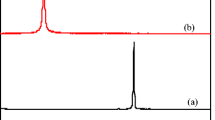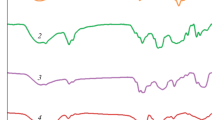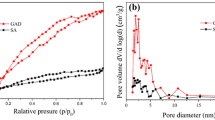Abstract
In this study, the innovative and multi-functional chitosan-based hydrogel beads were immobilized with silver nanoparticles (AgNPs) via polydopamine coating to simultaneously enhance antimicrobial and adsorption activity. The morphological observation under scanning electron microscopy along with elemental mapping by energy disperse X-ray spectrometer indicated that AgNPs were successfully synthesized and immobilized not only on the surface but also the interior of PDA-coated chitosan beads. The covalent silver–carboxylate linkage along with hydrophobic and Van der Waals forces was evidenced by Fourier transform infrared spectroscopy to further confirm the in situ synthesis of AgNPs on the surface of beads. The equilibrium swelling rate of the prepared hydrogel beads decreased as pH increased, being 160%, 100%, and 80% at pH 5, 7, and 9, respectively. The adsorption performance of the hydrogel beads was investigated for the removal of an anionic dye and a metal ion (Cu (II)). The presence of AgNPs enhanced the adsorption capacity of the beads for the above-mentioned adsorbates. The antimicrobial activities were determined against potential human pathogens including Gram-negative Escherichia coli and Gram-positive Staphylococcus aureus. The antimicrobial activity of the obtained beads on the Gram-negative bacteria was higher than on the Gram-positive bacteria. The obtained hydrogel beads could be used for simultaneously controlling chemical and biological contaminants in wastewater.
Graphical abstract

Polydopamine coating on chitosan beads enables the immobilization of in situ synthesized silver nanoparticles for superior adsorption and antimicrobial activity.









Similar content being viewed by others
References
Asano T, Burton F, Leverenz H (2007) Water reuse: issues, technologies, and applications. McGraw-Hill Education.
Aivalioti M, Papoulias P, Kousaiti A, Gidarakos E (2012) Adsorption of BTEX, MTBE and TAME on natural and modified diatomite. J Hazard Mater 207:117–127. https://doi.org/10.1016/j.jhazmat.2011.03.040
Bandura L, Kołodyńska D, Franus W (2017) Adsorption of BTX from aqueous solutions by Na-P1 zeolite obtained from fly ash. Process Saf Environ 109:214–223. https://doi.org/10.1016/j.psep.2017.03.036
Alqadami AA, Naushad M, Abdalla MA, Ahamad T, AlOthman ZA, Alshehri SM, Ghfar AA (2017) Efficient removal of toxic metal ions from wastewater using a recyclable nanocomposite: a study of adsorption parameters and interaction mechanism. J Clean Prod 156:426–436. https://doi.org/10.1016/j.jclepro.2017.04.085
Giacobbo A, Meneguzzi A, Bernardes AM, de Pinho MN (2017) Pressure-driven membrane processes for the recovery of antioxidant compounds from winery effluents. J Clean Prod 155:172–178. https://doi.org/10.1016/j.jclepro.2016.07.033
Jin X, Yu B, Lin J, Chen Z (2016) Integration of biodegradation and nano-oxidation for removal of PAHs from aqueous solution. ACS Sustain. Chem Eng 4(9):4717–4723. https://doi.org/10.1021/acssuschemeng.6b00933
Yamaga F, Washio K, Morikawa M (2010) Sustainable biodegradation of phenol by Acinetobacter calcoaceticus P23 isolated from the rhizosphere of duckweed Lemna aoukikusa. Environ Sci Technol 44(16):6470–6474. https://doi.org/10.1021/es1007017
Gatsios E, Hahladakis JN, Gidarakos E (2015) Optimization of electrocoagulation (EC) process for the purification of a real industrial wastewater from toxic metals. J Environ Manage 154:117–127. https://doi.org/10.1016/j.jenvman.2015.02.018
Kobya M, Demirbas E, Senturk E, Ince M (2005) Adsorption of heavy metal ions from aqueous solutions by activated carbon prepared from apricot stone. Bioresour Technol 96(13):1518–1521. https://doi.org/10.1016/j.biortech.2004.12.005
Gupta VK, Srivastava SK, Mohan D, Sharma S (1998) Design parameters for fixed bed reactors of activated carbon developed from fertilizer waste for the removal of some heavy metal ions. Waste Manage 17(8):517–522. https://doi.org/10.1016/S0956-053X(97)10062-9
Foo KY, Hameed BH (2010) An overview of dye removal via activated carbon adsorption process. Desalination Water Treat. 19(1–3):255–274. https://doi.org/10.1016/j.biortech.2004.12.005
Nieuwenhuijsen MJ, Toledano MB, Eaton NE, Fawell J, Elliott P (2000) Chlorination disinfection byproducts in water and their association with adverse reproductive outcomes: a review. Occup Environ Med 57(2):73–85. https://doi.org/10.1136/oem.57.2.73
Jolley RL, Brungs WA, Cotruvo JA, Cumming RB, Mattice JS, Jacobs VA (1983) Water chlorination: environmental impact and health effects. Volume 4, Book 1. Chemistry and water treatment, Ann Arbor Science Publishers, Ann Arbor, MI
Centers for Disease Control and Prevention (1999) Ten great public health achievements–United States, 1900–1999. MMWR. Morbidity and mortality weekly report 48(12):241–243
Ahmed EM (2015) Hydrogel: Preparation, characterization, and applications: a review. J Adv Res 6(2):105–121. https://doi.org/10.1016/j.jare.2013.07.006
Pakdel PM, Peighambardoust SJ (2018) Review on recent progress in chitosan-based hydrogels for wastewater treatment application. Carbohydr Polym 201:264–279. https://doi.org/10.1016/j.carbpol.2018.08.070
Van Tran V, Park D, Lee YC (2018) Hydrogel applications for adsorption of contaminants in water and wastewater treatment. Environ Sci Pollut Res 25(25):24569–24599. https://doi.org/10.1007/s11356-018-2605-y
Goy RC, Britto DD, Assis OB (2009) A review of the antimicrobial activity of chitosan. Polímeros 19(3):241–247. https://doi.org/10.1590/S0104-14282009000300013
Devlieghere F, Vermeulen A, Debevere J (2004) Chitosan: antimicrobial activity, interactions with food components and applicability as a coating on fruit and vegetables. Food Microbiol 21(6):703–714. https://doi.org/10.1016/j.fm.2004.02.008
Qu B, Luo Y (2020) Chitosan-based hydrogel beads: preparations, modifications and applications in food and agriculture sectors - a review. Int J Biol Macromol 152:437–448. https://doi.org/10.1016/j.ijbiomac.2020.02.240
Upadhyay U, Sreedhar I, Singh SA, Patel CM, Anitha KL (2021) Recent advances in heavy metal removal by chitosan based adsorbents. Carbohydr Polym 251:117000. https://doi.org/10.1016/j.carbpol.2020.117000
Wang T, Hu Q, Lee JY, Luo Y (2018) Solid lipid–polymer hybrid nanoparticles by in situ conjugation for oral delivery of astaxanthin. J Agric Food Chem. 66(36):9473-9480. https://doi.org/10.1021/acs.jafc.8b02827
Ball V (2018) Polydopamine nanomaterials: recent advances in synthesis methods and applications. Front Bioeng Biotechnol 6:109. https://doi.org/10.3389/fbioe.2018.00109
Baker C, Pradhan A, Pakstis L, Pochan DJ, Shah SI (2005) Synthesis and antibacterial properties of silver nanoparticles. J Nanosci Nanotechnol 5(2):244–249. https://doi.org/10.1166/jnn.2005.034
Franci G, Falanga A, Galdiero S, Palomba L, Rai M, Morelli G, Galdiero M (2015) Silver nanoparticles as potential antibacterial agents. Molecules 20(5):8856–8874. https://doi.org/10.3390/molecules20058856
Govindappa M, Farheen H, Chandrappa CP, Rai RV, Raghavendra VB (2016) Mycosynthesis of silver nanoparticles using extract of endophytic fungi, Penicillium species of Glycosmis mauritiana, and its antioxidant, antimicrobial, anti-inflammatory and tyrokinase inhibitory activity. Adv Nat Sci- Nanosci Nanotechnol 7(3):035014. https://doi.org/10.1088/2043-6262/7/3/035014
Xie P, Liu Y, Feng M, Niu M, Liu C, Wu N, Sui K, Patil RR, Pan D, Guo Z, Fan R (2021) Hierarchically porous Co/C nanocomposites for ultralight high-performance microwave absorption. Adv Compos Hybrid Mater 4(1):173–185
Wu N, Du W, Hu Q, Jiang SV (2021) Recent development in fabrication of Co nanostructures and their carbon nanocomposites for electromagnetic wave absorption. Eng Sci 13:11-23. https://doi.org/10.30919/es8d1149
Kodoth AK, Badalamoole V (2020) Silver nanoparticle-embedded pectin-based hydrogel for adsorptive removal of dyes and metal ions. Polym Bull 77(2):541–564. https://doi.org/10.1007/s00289-019-02757-4
Abdelkrim S, Mokhtar A, Djelad A, Bennabi F, Souna A, Bengueddach A, Sassi M (2020) Chitosan/Ag-bentonite nanocomposites: preparation, characterization, swelling and biological properties. J Inorg Organomet Polym Mater 30(3):831–840. https://doi.org/10.1007/s10904-019-01219-8
Narayanan A, Nair MS, Muyyarikkandy MS, Amalaradjou MA (2018) Inhibition and inactivation of uropathogenic Escherichia coli biofilms on urinary catheters by sodium selenite. Int J Mol Sci 19(6). https://doi.org/10.3390/ijms19061703
Qiu Y, Zhu Z, Miao Y, Zhang P, Jia X, Liu Z, Zhao X (2020) Polymerization of dopamine accompanying its coupling to induce self-assembly of block copolymer and application in drug delivery. Polym Chem 11(16):2811–2821. https://doi.org/10.1039/D0PY00085J
Bucher T, Clodt JI, Grabowski A, Hein M, Filiz V (2017) Colour-value based method for polydopamine coating-stability characterization on polyethersulfone membranes. Membranes 7(4):70. https://doi.org/10.3390/membranes7040070
Azizi S, Namvar F, Mahdavi M, Ahmad MB, Mohamad R (2013) Biosynthesis of silver nanoparticles using brown marine macroalga. Sargassum muticum aqueous extract. Materials 6(12):5942–5950. https://doi.org/10.3390/ma6125942
Bhagat M, Anand R, Datt R, Gupta V, Arya S (2019) Green synthesis of silver nanoparticles using aqueous extract of Rosa brunonii Lindl and their morphological, biological and photocatalytic characterizations. J Inorg Organomet Polym Mater 29(3):1039–1047. https://doi.org/10.1007/s10904-018-0994-5
Vona D, Cicco SR, Ragni R, Leone G, Presti ML, Farinola GM (2018) Biosilica/polydopamine/silver nanoparticles composites: new hybrid multifunctional heterostructures obtained by chemical modification of Thalassiosira weissflogii silica shells. MRS Commun 8(3):911–917. https://doi.org/10.1557/mrc.2018.103
Luo Y, Teng Z, Li Y, Wang Q (2015) Solid lipid nanoparticles for oral drug delivery: chitosan coating improves stability, controlled delivery, mucoadhesion and cellular uptake. Carbohydr Polym 122:221–229. https://doi.org/10.1016/j.carbpol.2014.12.084
Wang T, Luo Y (2018) Chitosan hydrogel beads functionalized with thymol-loaded solid lipid-polymer hybrid nanoparticles. Int J Mol Sci 19(10):3112. https://doi.org/10.3390/ijms19103112
Ma X, Wu G, Dai F, Li D, Li H, Zhang L, Deng H (2021), Chitosan/polydopamine layer by layer self-assembled silk fibroin nanofibers for biomedical applications. Carbohydr Polym 251:110758. https://doi.org/10.1016/j.carbpol.2020.117058
Ngoc-Thang N, Liu J-H (2014) A green method for in situ synthesis of poly(vinyl alcohol)/chitosan hydrogel thin films with entrapped silver nanoparticles. J Taiwan Inst Chem Eng 45(5):2827–2833. https://doi.org/10.1016/j.jtice.2014.06.017
Nesovic K et al (2019) Chitosan-based hydrogel wound dressings with electrochemically incorporated silver nanoparticles - in vitro study. Eur Polym J 121:109257. https://doi.org/10.1016/j.eurpolymj.2019.109257
Qu X, Wirsen A, Albertsson AC (2000) Novel pH-sensitive chitosan hydrogels: swelling behavior and states of water. Polymer 41(12):4589–4598. https://doi.org/10.1016/S0032-3861(99)00685-0
El-Hady A, Saeed S (2020) Antibacterial properties and pH sensitive swelling of insitu formed silver-curcumin nanocomposite based chitosan hydrogel. Polymers 12(11):2451. https://doi.org/10.3390/polym12112451
Yao KD et al (1994) Swelling kinetics and release characteristic of cross-linked chitosan - polyether polymer network (semi-ipn) hydrogels. J Polym Sci Part A- Polym Chem 32(7):1213–1223. https://doi.org/10.1002/pola.1994.080320702
Masood N et al (2019) Silver nanoparticle impregnated chitosan-PEG hydrogel enhances wound healing in diabetes induced rabbits. Int J Pharm 559:23–36. https://doi.org/10.1016/j.ijpharm.2019.01.019
Thamer BM et al (2020) In situ preparation of novel porous nanocomposite hydrogel as effective adsorbent for the removal of cationic dyes from polluted water. Polymers 12(12). https://doi.org/10.3390/polym12123002
Chatterjee S, Lee MW, Woo SH (2010) Adsorption of congo red by chitosan hydrogel beads impregnated with carbon nanotubes. Bioresour Technol 101(6):1800–1806. https://doi.org/10.1016/j.biortech.2009.10.051
Fan C et al (2016) The stability of magnetic chitosan beads in the adsorption of Cu2+. RSC Adv 6(4):2678–2686. https://doi.org/10.1039/C5RA20943A
Fan C et al (2018) Evaluation of magnetic chitosan beads for adsorption of heavy metal ions. Sci Total Environ 627:1396–1403. https://doi.org/10.1016/j.scitotenv.2018.02.033
IM Kenawy et al (2019) Melamine grafted chitosan-montmorillonite nanocomposite for ferric ions adsorption: central composite design optimization study J Clean Prod 241.https://doi.org/10.1016/j.jclepro.2019.118189
Futalan CM et al (2012) Copper, nickel and lead adsorption from aqueous solution using chitosan-immobilized on bentonite in ternary system. Sustain Environ Res 22(6):345–355
Durán N et al (2016) Silver nanoparticles: a new view on mechanistic aspects on antimicrobial activity. Nanomed-Nanotechnol Biol Med 12(3):789–799. https://doi.org/10.1016/j.nano.2015.11.016
Roy A et al (2019) Green synthesis of silver nanoparticles: biomolecule-nanoparticle organizations targeting antimicrobial activity. RSC Adv 9(5):2673–2702. https://doi.org/10.1039/C8RA08982E
Feng QL et al (2000) A mechanistic study of the antibacterial effect of silver ions on Escherichia coli and Staphylococcus aureus. J Biomed Mater Res 52(4):662–668. https://doi.org/10.1002/1097-4636(20001215)52:4%3C662::AID-JBM10%3E3.0.CO;2-3
Kim JS et al (2007) Antimicrobial effects of silver nanoparticles. Nanomed-Nanotechnol Biol Med 3(1):95–101. https://doi.org/10.1016/j.nano.2006.12.001
Vertelov GK et al (2008) A versatile synthesis of highly bactericidal Myramistin (R) stabilized silver nanoparticles. Nanotechnology 19(35). https://doi.org/10.1088/0957-4484/19/35/355707
Piras CC, Mahon CS, Smith DK (2020) Self-assembled supramolecular hybrid hydrogel beads loaded with silver nanoparticles for antimicrobial applications. Chem Eur J 26(38):8452–8457. https://doi.org/10.1002/chem.202001349
Park S et al (2018) Disinfection of waterborne viruses using silver nanoparticle-decorated silica hybrid composites in water environments. Sci Total Environ 625:477–485. https://doi.org/10.1016/j.scitotenv.2017.12.318
Long YM et al (2017) Surface ligand controls silver ion release of nanosilver and its antibacterial activity against Escherichia coli. Int J Nanomed 12:3193–3206. https://doi.org/10.2147/IJN.S132327
Liu J, Hurt RH (2010) Ion release kinetics and particle persistence in aqueous nano-silver colloids. Environ Sci Technol 44(6):2169–2175. https://doi.org/10.1021/es9035557
Funding
This work was, in part, supported by the U.S. Department of Agriculture (USDA), National Institute of Food and Agriculture, Specialty Crop Research Initiative, Award No. 2016-51181-25403, and Hatch Multistate project accession number 1020207.
Author information
Authors and Affiliations
Corresponding author
Ethics declarations
Conflict of interest
The authors declare no competing interests.
Additional information
Publisher's Note
Springer Nature remains neutral with regard to jurisdictional claims in published maps and institutional affiliations.
Rights and permissions
About this article
Cite this article
Wang, T., Wusigale, Kuttappan, D. et al. Polydopamine-coated chitosan hydrogel beads for synthesis and immobilization of silver nanoparticles to simultaneously enhance antimicrobial activity and adsorption kinetics. Adv Compos Hybrid Mater 4, 696–706 (2021). https://doi.org/10.1007/s42114-021-00305-1
Received:
Revised:
Accepted:
Published:
Issue Date:
DOI: https://doi.org/10.1007/s42114-021-00305-1




